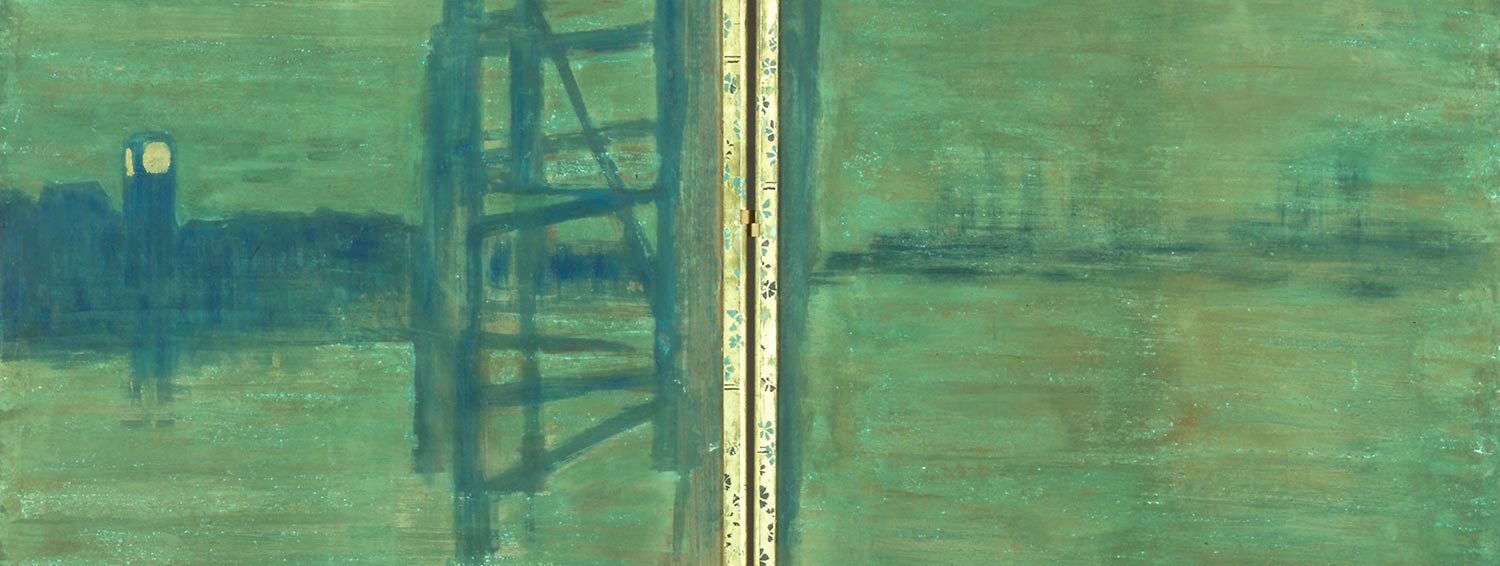Art Institute of Chicago
Whistler and Roussel: Linked Visions
June 20–September 27, 2015
Whistler and Roussel: Linked Visions will offer a new perspective on the nature of collaboration in late nineteenth-century London. Through side-by-side working sessions and collegial interaction in public and private settings, innovations in lithotint, transfer lithography, and color etching flourished in London’s artistic circles of the late nineteenth century. Built around the exceptional holdings of Whistler material in the Art Institute’s permanent collection—recently enhanced by a major gift of over 200 works by Theodore Roussel—this exhibition is anticipated to include works from private collections as well as the Terra Foundation for American Art. Major support for this exhibition has been provided by the Lunder Foundation. Whistler and Roussel: Linked Visions
Colby College Museum of Art
Whistler and the World:
The Lunder Collection of James McNeill Whistler
September 24, 2015–January 10, 2016
In his Ten O’Clock Lecture in 1885, James McNeill Whistler (American, 1834-1903) presented himself as an artist set apart from the public, bearing no relation to the historical moment he lived in. However, the myth of artistic independence that Whistler developed was but one part of a complex and highly significant relationship he had with the world around him. As a painter, printmaker, and designer, Whistler engaged with a variety of places, people, and ideas that stretched from the United States to London, Venice, and Japan. Drawn entirely from the renowned Lunder Collection, this comprehensive exhibition—featuring the finest examples of his prints among works in other media—explores Whistler’s travels across Europe in his quest to re-imagine his surroundings and to transport the modern world into the “realm of art.” Whistler and the World: The Lunder Collection of James McNeill Whistler
Aesthetic Harmonies: Whistler in Context
September 15, 2015–January 3, 2016
Aesthetic Harmonies explores the many artistic, social, and historical contexts in which we can situate the artist James McNeill Whistler. Drawing from the museum’s rich collections of European, American, and Asian art, the exhibition reexamines Whistler’s relationship to the Etching Revival in Britain, French Realism, American Impressionism, and transatlantic Aestheticism. It also places the artist’s experiments with color, form, beauty, and nature in dialogue with early American modernism, mid-twentieth-century abstraction, and contemporary art. Aesthetic Harmonies thus constructs a history of modern art through Whistler’s diverse practices, philosophies, and influences. This exhibition is curated by Associate Professor of Art Tanya Sheehan and the Fall 2014 students in AR497. Aesthetic Harmonies: Whistler in Context
Whistler: Nature and Nation
A Symposium Presented by the Lunder Consortium
for Whistler Studies
October 15, 2015
9 am – 5 pm
On October 15, 2015 the Colby College Museum of Art will host a one day symposium, Whistler: Nature and Nation. Generously supported by a grant from the Terra Foundation for American Art, the symposium is dedicated to the exploration of how the American artist James McNeill Whistler reimagined ideas of nature and nation in light of his international contexts and experiences. Speakers include leading scholars on Whistler and American art.
The symposium can be viewed in its entirety at: Whistler: Nature and Nation
The Freer Gallery of Art and Arthur M. Sackler Gallery
The Peacock Room Comes to America
April 9, 2011–January 3, 2016
Freer Gallery of Art
For the first time, the Freer Gallery’s renowned Peacock Room has been restored to its appearance in 1908, when museum founder Charles Lang Freer used it to display more than 250 ceramics he had collected from throughout Asia. When American expatriate artist James McNeill Whistler redecorated the room in 1876 and 1877 as a “harmony in blue and gold,” he was inspired by the delicate patterns and vivid colors of the Chinese porcelains. Their slick surfaces, however, did not appeal to Freer, who favored complex surface textures and subtly toned glazes. After he purchased the Peacock Room and moved it from London to his mansion in Detroit in 1904, Freer filled the shelves with pots he had acquired from Egypt, Iran, Japan, China, and Korea. Much like the room’s arrangement in Detroit more than a century ago, this exhibition underscores Freer’s belief that “all works of art go together, whatever their period.” Peacock Room Comes to America
Freer and Whistler: Points of Contact
Continuing through January 3, 2016
Freer Gallery of Art
This exhibition of 20 oil paintings represents a choice selection of the more than 1,300 works by Whistler in the Freer Gallery of Art. These highlights—including Japonesque costume pictures, atmospheric views of the river Thames, and the suite of oil studies known as the Six Projects— were chosen to exemplify both Freer’s philosophy of collecting and Whistler’s own self-conscious synthesis of western and Asian artistic traditions. Freer and Whistler: Points of Contact
Fine Impressions: Whistler, Freer, and Venice
October 18, 2014–November 2, 2015
Freer Gallery of Art, ground floor
In 1887, museum founder Charles Lang Freer purchased the entire Second Venice Set, twenty-six atmospheric etchings by James McNeill Whistler. This precipitous act marked the beginning of a long and fruitful partnership between collector and artist, which eventually led to the founding of the Freer Gallery, today the world’s largest and finest repository of Whistler’s works. Fine Impressions shows how Freer’s acquisition of the Second Venice Set came to shape his legacy as a connoisseur and collector.
An American in London: Whistler and the Thames
May 3, 2014–August 17, 2014
American artist James McNeill Whistler (1834–1903) arrived in London in 1859 and discovered in its neighborhoods and inhabitants an inexhaustible source of aesthetic inspiration. His images of the city created over the next two decades represent one of his most successful and profound assaults on the contemporary art establishment. In the Sackler’s first major Whistler exhibition, more than seventy works—paintings of famed London sites in Chelsea and along the Thames River, as well as prints and rarely seen drawings, watercolors, and pastels—presented a captivating survey of the artist’s unique depictions of a rapidly changing urban environment. The exhibition culminated with an ensemble of Whistler’s most iconic nocturnes, including Blue and Gold—Old Battersea Bridge (1872–77). An American in London: Whistler and the Thames
Off the Beaten Path: Early works by James McNeill Whistler
September 28, 2013–September 28, 2014
In the summer of 1858, twenty-four-year-old Whistler traveled with a friend from Paris through the Rhineland. Their goal was to reach Amsterdam and view The Night Watch and other paintings by Rembrandt van Rijn—but they soon ran out of money and were forced to return to Paris. Their excursion through the countryside, where they drew portraits in exchange for food and lodging, resulted in a body of work that for years served as source material for the artist. The drawings, etchings, and watercolors on view not only document Whistler’s adventures, but they also shaped his selection of subject matter and his approach to composition, light and shadow, and perspective. Off the Beaten Path: Early Works by James McNeill Whistler
Whistler’s Neighborhood: Impressions of a Changing London
September 8, 2012–September 2, 2013
James McNeill Whistler (1834–1903) lived in London’s Chelsea neighborhood from 1863 until his death. Bordering the River Thames, Chelsea was home to artists, aristocrats, tradesmen, and paupers. Whistler depicted the storefronts and street life outside his door and captured a section of the city that was undergoing a dramatic transformation in the 1880s. Historic buildings were razed and replaced with mansions for the upper class, forcing the poor into squalid conditions. The Thames Embankment, a major public works project designed to improve river navigation and provide underground sewers, changed the topography of Chelsea by claiming much of the riverbank for public gardens and new residential buildings. The diminutive etchings in Whistler’s Neighborhood: Impressions of a Changing London, which also features watercolors and small oil paintings, underscore the immediacy of the artist’s quick impressions of his evolving neighborhood. Together, the works form a panorama of Chelsea in the 1880s. Whistler’s Neighborhood
Sweet Silent Thoughts: Whistler’s Interiors
August 20, 2011–August 19, 2012
In Victorian England in the nineteenth century, life was separated into gendered spheres. The masculine realm was often characterized by outward-directed activities of physical exertion, industry, and business. Women, on the other hand, were identified with the private world of imagination and self-reflection, as seen in this selection of prints by American expatriate artist James McNeill Whistler. Images of private, enclosed spaces, inhabited by quiet, self-contained figures, recur from his earliest etchings in the mid-1850s to his later watercolors and lithographs. Family members, close friends, or the artist’s current mistress almost always serve as the focus of these interior scenes. This sense of intimacy is underscored by the works’ small scale, which compels the viewer to stand close and study the scene carefully. Whistler’s interiors thus encourage us to retreat—like his subjects—into a realm of “sweet silent thought.” Sweet Silent Thoughts: Whistler’s Interiors
University of Glasgow
Lunder International Whistler Scholars’ Colloquium
June 4–5, 2015
The Whistler Group at the University of Glasgow in association with the Lunder Consortium for Whistler Studies organized and hosted an invited Colloquium of international scholars from 4 to 5 June 2015. Participants came from the UK, US, Germany and Australia. The full program reviewed current activity in Whistler studies, shared information and learnings, stimulated lively debate, and identified new areas of activity for the Lunder Consortium for Whistler Studies, for research, teaching, exhibitions, publications and public engagement.
James McNeill Whistler Retrospective
September 2014–March 2015
The Hunterian was the principal lender to the first major exhibition of Whistler’s work in Japan for over 30 years, lending over 60 works to the showings at the National Museum of Modern Art, Kyoto and Yokohama Museum of Art, and the principal contributor to the catalogue. The loans included oil paintings, etchings, lithographs, artist’s materials, and Chinese porcelain and European silver collected by Whistler and his wife, Beatrix Whistler. The exhibition showings ran from September 2014 to March 2015.
Banner image: Blue and Silver: Screen with Old Battersea Bridge, 1871-72, Distemper and gold paint on brown paper laid on canvas stretched on back of silk, The Hunterian, University of Glasgow.

